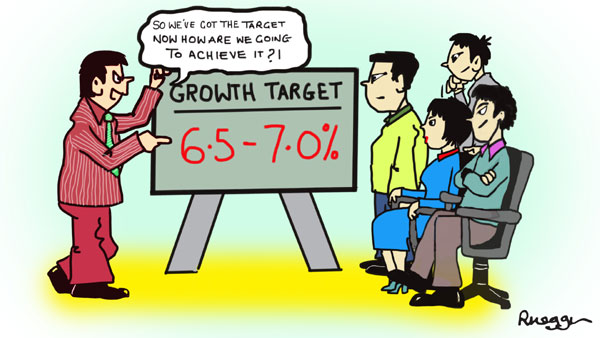Thoughts on China's economic targets in 2016 and beyond
- By Zongxin Qian
 0 Comment(s)
0 Comment(s) Print
Print E-mail CRI, March 9, 2016
E-mail CRI, March 9, 2016
|
Illustration by Robert Wiggin |
On March 5, 2016, Chinese Premier Li Keqiang reported the objectives of the government in the next five years to the National People's Congress. The targets for gross domestic product and per capita income, to be achieved by 2020, are set at twice the level of those for 2010. The targeted economic growth rate is set at 6.5 percent. There is also a target for reform on the economic structure. The shares of advanced manufacturing, modern services, and strategic emerging industries in aggregate output should have significantly increased by 2020. The importance of technological progression for economic growth has been addressed by Premier Li. More specifically, there are also technology-related targets set by the government. Total spending on research and development for the entire economy has to reach 2.5 percent by 2020 and the contribution of technological progression towards economic growth has to reach 60 percent.
The target growth rate, 6.5 percent, is a much smaller number than the average number in the past 10 years, but is still relatively high compared to most major economies around the world. The government has a relatively high growth target for at least two reasons. First, a higher growth rate creates more consumable resources for the citizens, and hence can improve their living standards. This is particularly important for fighting poverty. Second, a reasonable growth rate is necessary for offering enough employment opportunities. The target growth rate is smaller than those of the past for at least two reasons. On the one hand, the world economic outlook is still not that good, which means that external demand-led growth, similar to that of the past, is no longer possible. On the other hand, economic structural reform comes at a cost. Those reforms are aimed at bringing more sustainable growth in the long-run but might slow down growth in the short run. For example, the government aims to increase the share of the service sector in terms of aggregate output. In the short run, the growth of the service sector might attract resources from the manufacturing sector and slow down its growth.
In Premier Li's report, the growth target for 2016 is set to be 6.5 - 7 percent. This target is believed to be enough for maintaining full employment and Premier Li explicitly mentioned that the target is set with consideration of the needs of economic reforms. Maintaining structural reform targets while aggregate growth is under threat is a brave decision. However, it is also necessary. The difficulties that China has faced since the onset of the global financial crisis are deeply rooted in our economic structure. In the past, rapid economic growth relied too much on exports and investment. This made the economy vulnerable to external shocks. China has a huge export sector, but many of the exporting firms are producing highly substitutable goods. Tougher international competition and rising labor costs suggest that the profit margin of those firms will decline. Innovation and technological progression can, however, enhance the international competitiveness of China's exporting sector. The transition from a traditional manufacturing sector to advanced manufacturing, modern services, and strategic emerging industries can also improve the country’s competitive advantage.
Notably, in 2016, there are also targets for energy consumption and pollution control. More specifically, the energy consumption per unit of GDP has to drop by more than 3.4 percent, and emissions of major pollutants have to decline. In the past, the high growth number is partly supported by high energy consumption and pollution. Therefore, with the energy consumption and pollution control targets, 6.5 - 7 percent in 2016 is actually a better target than 6.5 - 7 percent in previous years.






